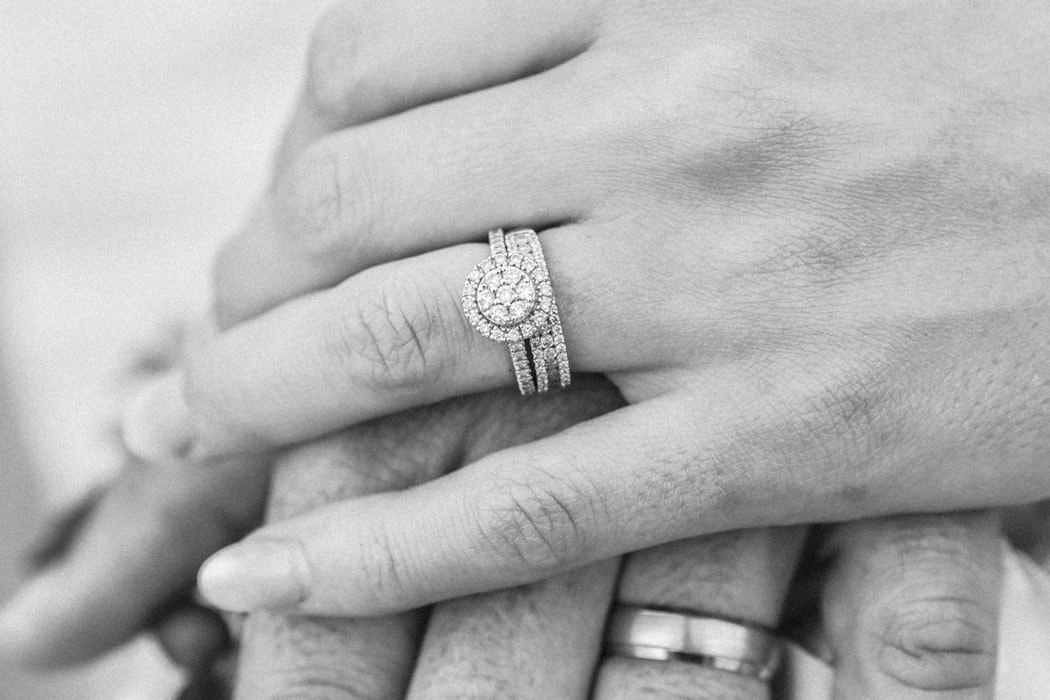
Table of Contents
The pave setting is one of the most popular options for engagement rings and wedding bands today. It’s easy to see the attraction – pave settings make for stylish, brilliant and luxurious looking rings.
Here’s what you need to know about the pros and cons of pave settings and shopping tips to help you make an informed decision.
What is the Pave Setting?
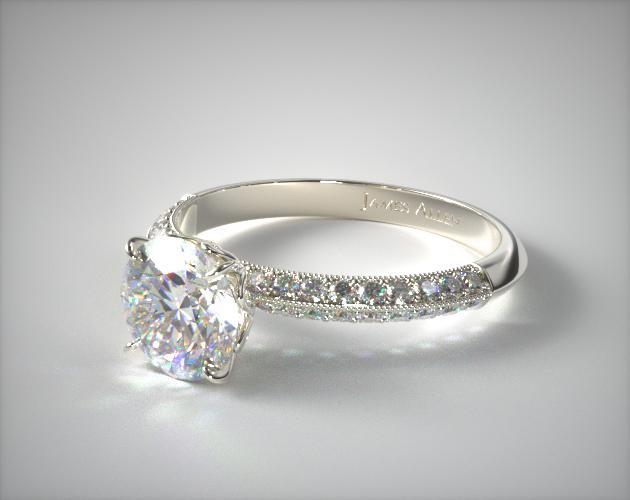
The pave (pronounced pa-vay) setting gets its name from the French word for paved, as in paving the ring with tiny diamonds (much like a street paved with cobblestones). This is because it features many tiny diamonds or other gemstone set close to each other, to pave the outer exterior of the ring setting. A pave setting can be a single row of tiny diamonds or made up of multiple rows.
Pave can elevate the look of even the simplest ring design, adding sparkle and style. Because it’s more of a design element rather than a type of setting per se, pave can be added to just about any ring design. This makes it a highly popular choice for engagement rings.
The diamonds used in a pave setting are miniscule, known as diamond melees, and are often around .01 to .02 carats in size. If the diamonds are even smaller than this, then the setting is considered a micro-pave setting.
How Are Pave Diamonds Set?
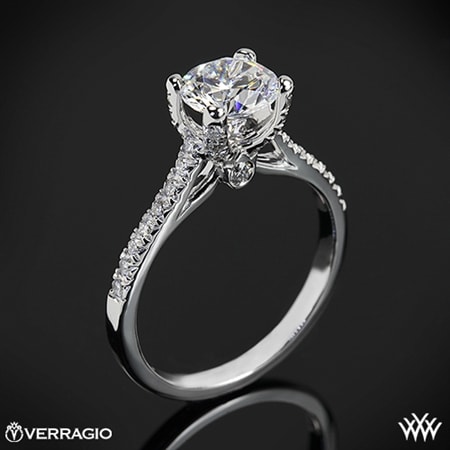
The diamonds on a pave setting are typically held in place by small metal beads or tiny prongs. The diamonds are first placed into tiny holes drilled into the setting, which provides addition security and holds the stones in place. The beads are then fixed around the diamond to hold it in place.
While the stones are generally very secure, there is some risk of a stone falling out or getting loose especially if struck a hard blow. Replacing a lost stone is often fairly easy to do and doesn’t necessarily cost much. It’s always a good idea to have your ring checked periodically to ensure that the stones are secure and the prongs are stable.
Do Pave Settings Save You Money?
As you might know, small diamonds are abundant, don’t require too much faceting, and are therefore quite inexpensive. So you would think that a pave setting wouldn’t cost too much, going on the price of melee diamonds alone.
However, this isn’t necessarily the case with pave settings. Creating a pave setting requires more labor, effort and materials than most other ring settings. Most pave rings are hand crafted, with each tiny diamond placed one by one into position by the jeweler. In addition, the diamonds need to be carefully chosen to ensure uniformity and consistency.
This is a labor-intensive process which requires highly skilled craftsmanship. The end result is a more expensive ring setting.
To illustrate this, compare this 14K white gold 1.8mm solitaire ring to this similar pave ring. The price of the pave setting is almost twice that of the plain band setting.
Pros and Cons of the Pave Setting
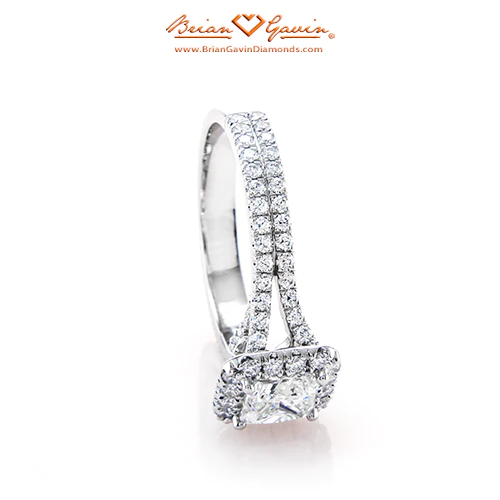
If you’re considering the pave setting, note that there are pros and cons to any ring setting.
Pros of Pave Setting:
- The pave setting accentuates the center stone, drawing attention to it. When the ring setting features pave on the shanks, leading to the center stone, it draws the eye towards the stone. To further enhance the size of the center stone, choose a thin ring band for your pave setting.
- Pave adds ample sparkle to your ring, making it brilliant and luxurious looking. The difference between a plain band and a pave band are huge, giving a glittering, stylish effect to the overall ring design.
- Pave can be added onto a wide range of engagement and wedding ring settings, making it a versatile option. This is because pave isn’t a setting in itself but simply a type of embellishment that can be added onto most ring styles.
Cons of Pave Setting:
With all these benefits, it’s easy to overlook the downsides. However, note that every type of ring setting has some disadvantage that you would need to deal with.
- As we discussed above, pave settings are typically an expensive type of setting, although this depends on a number of factors including the size of the setting and the amount of pave used.
- Cleaning a pave setting can be difficult as there are more grooves and hidden areas where dirt could get lodged. Regular cleaning may be required to ensure that the ring setting is sparkling and beautiful, instead of dull and dirty.
- Resizing a pave setting can prove difficult, especially if the pave surrounds the entire shank. To avoid issues, it’s important to get the right ring size at the start.
- There is some likelihood (however small) of pave stones getting dislodged or loose if struck a hard blow. This could happen with any type of setting, and isn’t a con that’s specific to pave settings only.
Types of Pave Ring Designs
There are many types of pave ring settings on the market, some with slight variations in the pave technique. Here are some of the best pave rings out there:
1. French Pave Engagement Ring
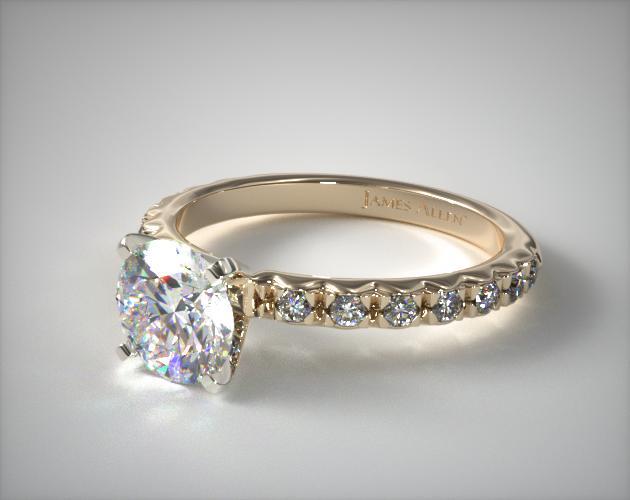
French pave is a unique pave technique, where the diamonds are set into tiny hand cut V shapes in the band of the ring. This works somewhat like an illusion setting, creating drama and complexity with fewer diamond melees used.
2. Micro Pave Ring
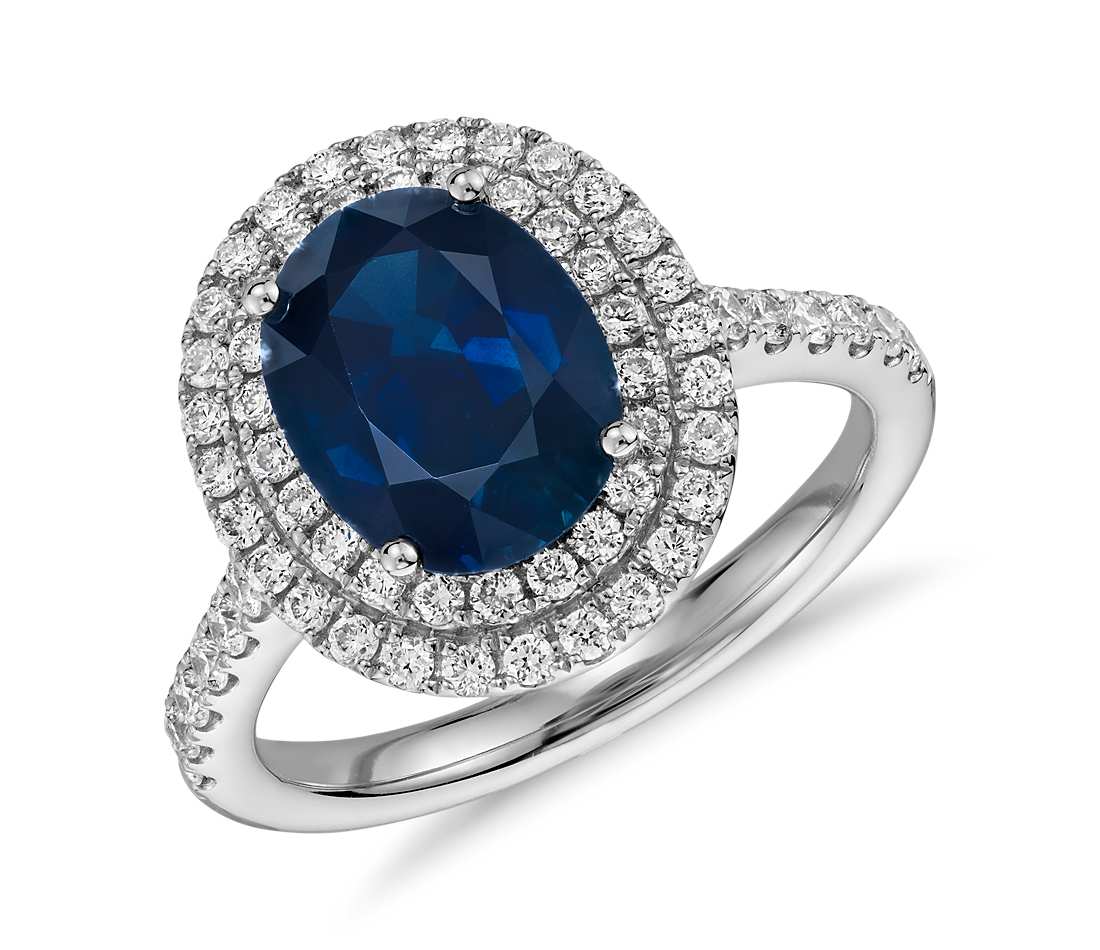
Micro pave follows the same concept of pave rings, with the main difference being that micro pave settings incorporate smaller diamonds than pave settings. Because the diamonds are smaller, they appear to blend into each other creating a setting that appears even more brilliant and glittery.
3. Pave Set Wedding Bands
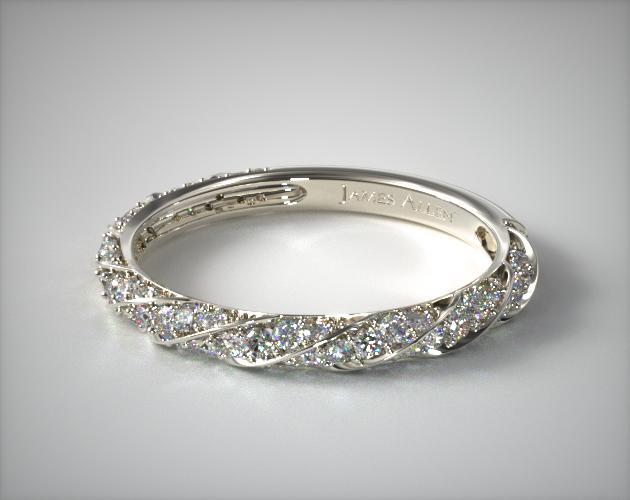
Pave is an excellent option for wedding bands and perfectly match a pave engagement ring. If your engagement ring is a plain band, choosing a pave wedding band can add that extra sparkle to elevate both rings.
4. Gemstone Pave Rings
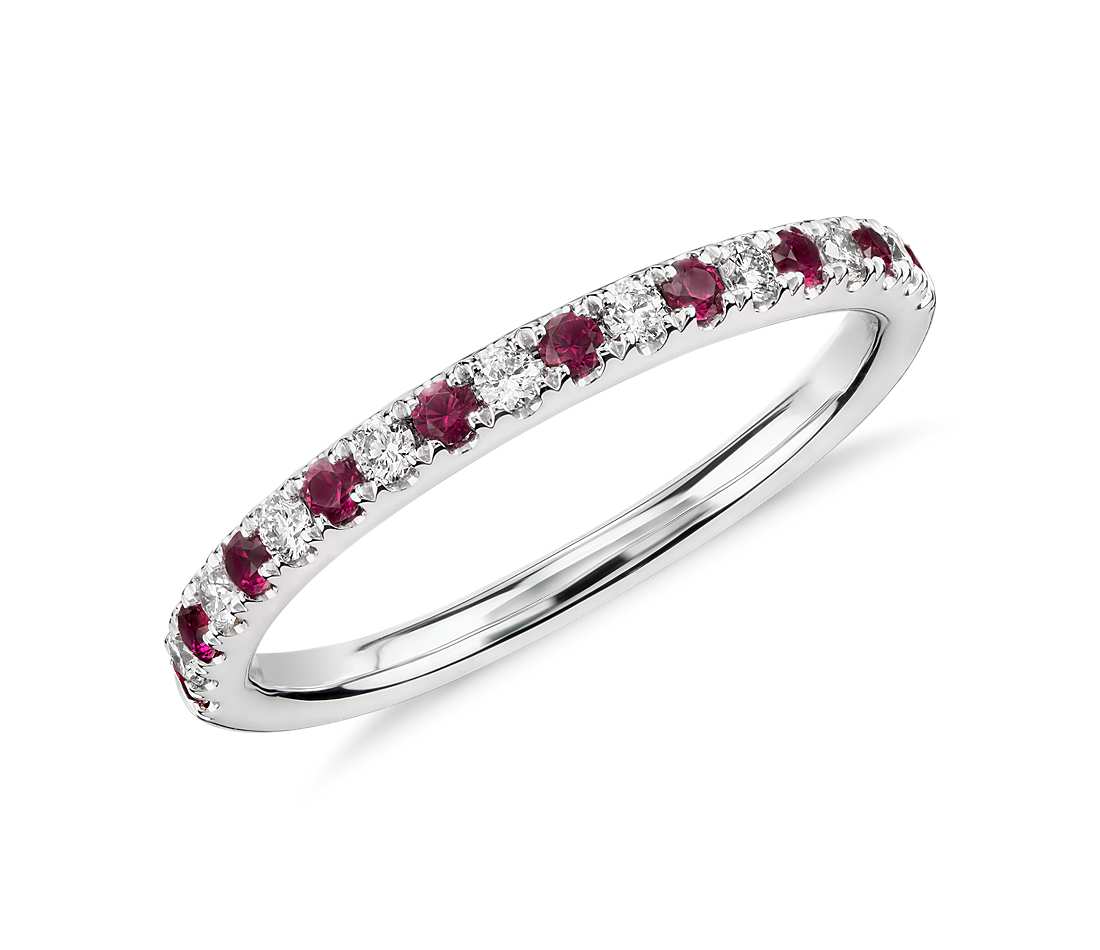
While diamonds remain the most popular stone for pave bands, gemstones like ruby, sapphire or morganite can add color and style to a pave setting. While these will not have the sparkle of diamonds, they add a unique look to an engagement or wedding band.
To have the best of both worlds (i.e. sparkle and color) you could opt for an alternating gemstone and diamond pave band, like the image featured above. However, ensure that the gemstones you choose are durable enough to withstand regular wear.
Shopping Tips for Pave Settings
When shopping for a pave setting, here are some points to note:
- Metal: While there isn’t a right or wrong metal choice for pave settings, choosing a white metal, like platinum or white gold, will accentuate the brilliance of the pave setting. This is because the metal beads or prongs holding the diamond will not be visible, creating no contrast in the setting.
- Stones: Check that the stones set into the pave ring are uniform, with no single stone standing out due to a difference in color or quality.
- Craftsmanship: Look for quality in the craftsmanship of the ring. Are the beads holding each stone securely? Is any bead or prong misshapen? Is the surface of the stones smooth and aligned, with no single stone protruding more than required? These are some questions that will help you with quality.
- Retailer: Choose a retailer that you can trust, with a proven track record. If you’re shopping online, you’ll have a lot more choice and competitive prices.
Where to Buy Pave Setting Rings?
Choosing your retailer carefully will ensure that you have a smooth buying process and high quality products. Always check the after sales policies, especially the returns policy, as the retailer should be able to stand by their products and take them back in case of any issues. Note, however, that most retailers will not accept custom made rings.
We recommend the following retailers, based on their extensive experience, positive track record, quality products and excellent customer service.
1. James Allen
James Allen offers attractive prices, high-quality products and amazing diamond imagery. Examine the products at up to 40x magnification with HD videos of incredible quality. They have a range of excellent pave settings and experts to walk you through your purchase.
2. Blue Nile
With the largest online inventory of diamonds, Blue Nile has an incredible range of diamonds and diamond jewelry to choose from. Their ring settings are stunning and the prices are highly competitive.
3. Brian Gavin
For top cut quality, Brian Gavin is an excellent option. They offer a wide range of designer ring settings and stunning diamonds in various categories. We particularly love the Brian Gavin Blue collection for an excellent diamond at a reasonable price.
4. Whiteflash
Whiteflash is known for their superior cut quality – the cream of the crop. If you’re focused on a brilliant diamond with exception sparkle and fire, mounted on high-quality settings, we recommend checking out what Whiteflash has to offer.
Wrapping Up
Pave settings are among the most brilliant and sparkly – perfect for those who want a ring that stands out on their finger. But note that resizing a pave setting and keeping it clean can be more difficult.









